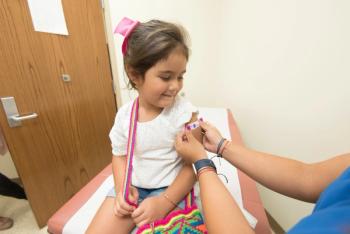
Novel Strategies Improve Screening for STDs
At the Centers for Disease Control and Prevention 2016 STD Prevention Conference, lead authors of several studies discussed how researchers are taking novel approaches to sexually-transmitted infection screening.
Researchers are taking novel approaches to sexually-transmitted infection (STI) screening, and lead authors of several studies described their innovations in a mini-plenary on September 21 at the Centers for Disease Control and Prevention (CDC) 2016 STD Prevention Conference in Atlanta, Georgia.
Tiffany E. Deihl, MD, described an STD tracking system that she and her colleagues at Magee-Womens Hospital in Pittsburgh, Pennsylvania, developed and tested.
"A simple STD tracking system designed as a reminder for clinicians resulted in a 26.5% increase in repeat testing of women at three months following chlamydia or gonorrhea. An STD tracker reminder tool is an effective strategy that can be easily adopted in other clinics to increase retesting rates, and may decrease complications related to repeat infections with chlamydia or gonorrhea," the authors wrote in their study abstract.
Repeat chlamydia and gonorrhea infections are common and increase the risk of pelvic inflammatory disease in women. Even though the CDC recommends retesting three months after treatment, retesting rates are low, they wrote.
"STD tracker," a database of all non-pregnant women who tested positive for chlamydia or gonorrhea in the clinic, enables gynecology clinic nursing staff to schedule or reschedule follow-up visits for repeat testing. Dr. Deihl and her colleagues reviewed electronic charts to compare the retesting rates before and after they began using the tracker.
From September 2012 to September 2014, 34% (181 of 525) of women returned for repeat testing within three months of their positive diagnosis. After the clinic began to use the STD tracker (October 2014 to September 2015), the rate of repeat STD testing within three months grew to 43% (104 of 243, P <0.05). At 6 months, the rate remained higher in the women contacted using the STD Tracker (57% versus 47%, P <0.01). Reinfection rates for chlamydia or gonorrhea at 3 months were 17% (16% before and 19% after the STD tracker was introduced).
Thomas Gift, PhD, and his colleagues estimated the impact and cost-effectiveness of fully putting into practice the US Preventive Services Task Force (USPSTF) and the CDC chlamydia and gonorrhea screening guidelines and advise that doing so could benefit the nation's health.
The research team used a transmission model of chlamydia screening in women under 25 years of age to estimate the impact of offering screening to 100% of eligible women aged 15 through 44, assuming that 95% would accept screening if offered.
Using data from NHANES (National Health and Nutrition Examination Survey), they determined the expected change in chlamydia prevalence in men and women compared to no screening, and they estimated the impact of a combined chlamydia-gonorrhea program.
According to their estimates, offering annual chlamydia and gonorrhea screening to all eligible women between the ages of 15 and 44 would reduce the population prevalence of chlamydia and gonorrhea by 32.1% in women and 10.4% in men compared to no screening, with a net cost of $32,825 per quality-adjusted life-year (QALY) over no screening.
The USPSTF and the CDC recommend annual chlamydia and gonorrhea screening for sexually active young women under 25 years and for older women with elevated risk, but available data suggest that fewer than half of sexually active women in this age group are screened annually for chlamydia.
Shantel Muldrew, MPH, and her colleagues found that, in 1,346 MSM who visited 12 STD clinics conducted by the Los Angeles County Department of Public Health, a pilot universal extragenital chlamydia/gonorrhea screening protocol identified more infections.
Muldrew and her co-authors reviewed the medical records of MSM patients seen during the 6 months before the new protocol took effect (February-August, 2014) and 6 months from the date the new protocol began (February-August, 2015).
For each clinic, they compared before-and-after percentages of visits that included universal (urogenital, oropharyngeal, and anorectal) screening and positive chlamydia/gonorrhea lab tests anywhere on the body. They calculated the before-and-after percentages of visits that included universal screening, and they scored improvement as: high (>10% increase), medium (1-10% increase), or no improvement or decrease.
The overall proportion of visits that included universal screening increased 6.5% (60.6% of 815 before vs 67.1% of 1,099 after; P <0.001) with wide variation across clinics (range: -3.1% to 30.7%).
The proportions of visits with a chlamydia/gonorrhea diagnosis before and after the new screening practices at high-, medium-, and no- or decreased-improvement clinics were 4.9%, 1.1%, and -7.3%, respectively.
In multivariate models, the odds ratios of chlamydia/gonorrhea diagnoses during the before- vs after-protocol period were 1.40 (95%CI, 1.12 to 1.76; P <0.01) and 1.37 (95%CI, 1.05 to 1.78; P = 0.02) times greater at high- and medium-improvement clinics compared to no- or decreased-improvement clinics.
Adam Cohen, MPH, PhD, discussed his study results showing that the smartphone application, Healthvana, used by the AIDS Healthcare Foundation (AHF), reports chlamydia, gonorrhea, and syphilis test results to the patient as soon as the lab puts them online, shortening the time from testing to notification and from testing to treatment by roughly two days each, compared with AHFs previous system of notifying people who tested positive by phone.
"Clients have less time to unknowingly infect others, and the pressure on the staff due to the need to notify clients by phone is eased," Dr. Cohen told Contagion.
In 2014, AHF switched its protocol from notifying clients by phone that they tested positive and need to come in for treatment, to using Healthvana, which gave clients and the clinic the test results immediately after the lab puts them online.
Dr. Cohen carried out a cross-sectional study of clients who received STI testing services through AHF between January 2014 and December 2015 who tested positive, were notified of their results, and returned for treatment.
He compared the time between testing, notification, and return for treatment before and after Healthvana was introduced.
The 779 clients who were phoned averaged 12.55 days between test and treatment, compared with 10.68 days between test and treatment for the 681 clients who use the app.
For clients who used the app, the test-to-treatment period shortened by 1.87 days (P <0.05); the test-to-notification period decreased by 1.95 days (P <0.05); and the number of days from notification to treatment increased a nonsignificant 0.07 days (P = 0.810).
The number of days between test and treatment dropped by 15% (P <0.05); the days between test and notification decreased by 22% (P <0.05); and the time between notification and treatment went up by 2% (P = 0.084).
AHF is the largest provider of HIV/AIDS medical care for HIV/AIDS in the United States, Dr. Cohen said in his talk. The organization is a global nonprofit organization that provides medicine and advocacy to people in 36 countries regardless of their ability to pay, according to its website.
Brooke Hoots, PhD, MSPH, presented findings about chlamydia and gonorrhea testing and diagnosis among men who have sex with men (MSM) in 20 US cities.
"Diagnoses of both chlamydia and gonorrhea increased beyond the magnitude of the increases in testing between 2011 and 2014 after adjustment," the authors wrote in their abstract. "Increased efforts are needed to meet annual STD screening recommendations among MSM at high risk for HIV."
To assess the differences between 2011 and 2014 in self-reported chlamydia testing and diagnosis, and gonorrhea testing and diagnosis, in the previous 12 months among MSM, Dr. Hoots and her colleagues used data from the National HIV Behavioral Surveillance (NHBS), which monitors HIV-associated behaviors and HIV prevalence in cities with high AIDS burden.
"NHBS collects data on three populations at high risk in annual rotating cycles: MSM, people who inject drugs, and heterosexuals at high-risk for HIV infection," she explained.
The researchers analyzed self-reported data from 9,256 MSM in 2011, and 9,640 MSM in 2014, who had one or more male partners during the previous 12 months. Most men were between 18 and 29 years of age. Adjusted prevalence ratios (aPR) estimated the differences in testing and diagnosis between the years.
Overall, testing for chlamydia increased from 37.8% in 2011 to 47.1% in 2014 (aPR): 1.19, 95% confidence interval (CI), 1.15 to 1.24) and for gonorrhea, from 38.8% to 47.8% (aPR: 1.18, 1.14 to 1.22).
Testing for both STDs was more prevalent among younger MSM and those who had more education, had health insurance, and were HIV positive; all subgroups showed similar increases.
Chlamydia diagnoses grew from 9.2% in 2011 to 11.4% in 2014 (aPR: 1.28, 1.10 to 1.49).
Greater increases occurred among MSM in the white and “other” racial categories, MSM with more education, and HIV-positive MSM. Gonorrhea diagnoses rose from 12.1% in 2011 to 15.1% in 2014 (aPR: 1.41, 95% CI: 1.23-1.61). Greater increases were found among MSM in the white and ‘other’ racial categories and those who had more education, health insurance, and sex partners during the previous 12 months.
Lorraine L. Janeczko, MPH, is a medical science writer who creates news, continuing medical education and feature content in a wide range of specialties for clinicians, researchers and other readers. She has completed a Master of Public Health degree through the Department of Epidemiology of the Johns Hopkins Bloomberg School of Public Health and a Dana Postdoctoral Fellowship in Preventive Public Health Ophthalmology from the Wilmer Eye Institute, the Johns Hopkins University School of Medicine and the Bloomberg School.
​SOURCES: 2016 CDC STD Prevention Conference Program pp 57-58: Keeping Out the Bugs: Novel Strategies To Improve STI Screening (
(Sources for studies: abstracts, slides, audio recordings, interviews)
Presentations:
Tiffany E. Deihl, MD, resident physician, Department of Obstetrics, Gynecology and Reproductive Sciences, Magee-Womens Hospital of the Universtiy of Pittsburgh Medical Center (UPMC), Pennsylvania, STD Tracker Reminder System Increases Repeat Testing Following Treatment for Chlamydia or Gonorrhea
Thomas Gift, PhD, economist, Division of STD Prevention, CDC, Atlanta, Georgia, Estimating the Impact and Cost-Effectiveness of Full Implementation of Screening Guidelines for Chlamydia and Gonorrhea in the United States
Shantel Muldrew, MPH, epidemiologist, Division of HIV and STD Programs, Los Angeles County Department of Public Health, Los Angeles, California, Results from a Pilot of Universal Extra-Genital Chlamydia and Gonorrhea Screening Among Men Who Have Sex With Men (MSM) Who Attend Los Angeles County STD Clinics
Adam Cohen, PhD, MPH, director of advocacy and policy research, AIDS Healthcare Foundation (AHF), Los Angeles, California, Reduction in Time to Treat after Implementation of Electronic Sexually Transmitted Infection (STI) Test Results Delivery through Healthvana
Brooke Hoots, PhD, MSPH, epidemiologist, CDC Division of HIV/AIDS Prevention, Atlanta, Georgia, Chlamydia and Gonorrhea Testing and Diagnosis Among Men Who Have Sex with Men -- 20 U.S. Cities, 2011 and 2014
Newsletter
Stay ahead of emerging infectious disease threats with expert insights and breaking research. Subscribe now to get updates delivered straight to your inbox.
































































































































































































































































































































